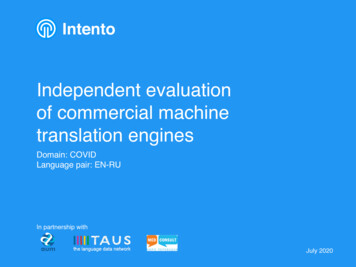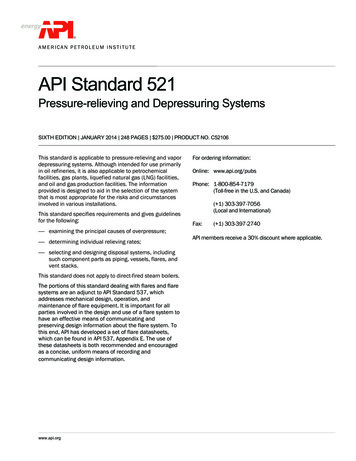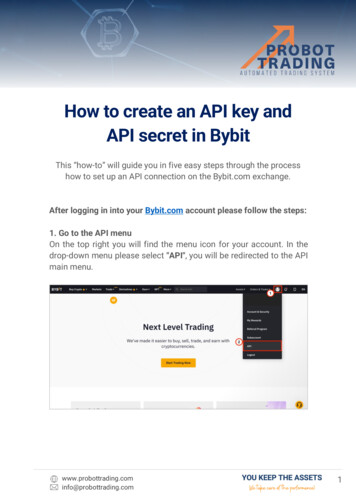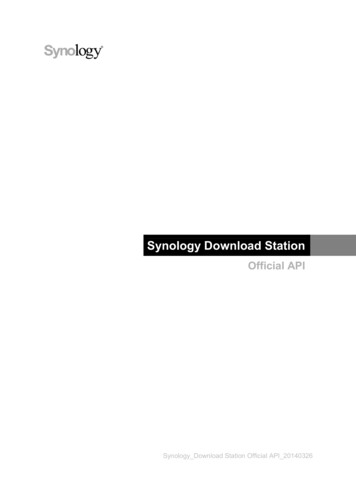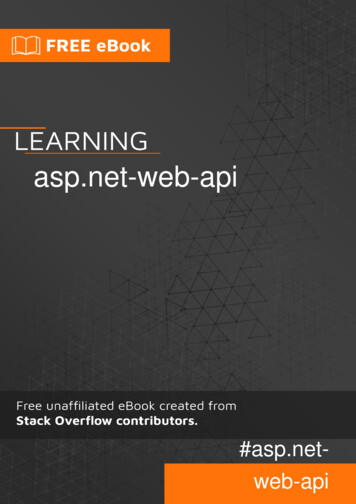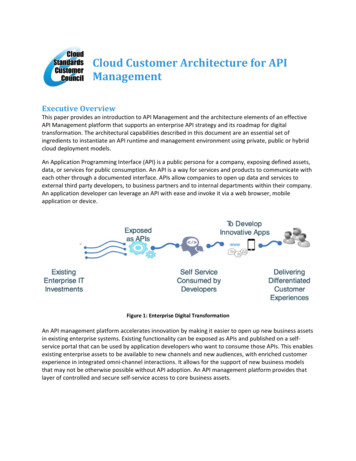
Transcription
Cloud Customer Architecture for APIManagementExecutive OverviewThis paper provides an introduction to API Management and the architecture elements of an effectiveAPI Management platform that supports an enterprise API strategy and its roadmap for digitaltransformation. The architectural capabilities described in this document are an essential set ofingredients to instantiate an API runtime and management environment using private, public or hybridcloud deployment models.An Application Programming Interface (API) is a public persona for a company, exposing defined assets,data, or services for public consumption. An API is a way for services and products to communicate witheach other through a documented interface. APIs allow companies to open up data and services toexternal third party developers, to business partners and to internal departments within their company.An application developer can leverage an API with ease and invoke it via a web browser, mobileapplication or device.Figure 1: Enterprise Digital TransformationAn API management platform accelerates innovation by making it easier to open up new business assetsin existing enterprise systems. Existing functionality can be exposed as APIs and published on a selfservice portal that can be used by application developers who want to consume those APIs. This enablesexisting enterprise assets to be available to new channels and new audiences, with enriched customerexperience in integrated omni-channel interactions. It allows for the support of new business modelsthat may not be otherwise possible without API adoption. An API management platform provides thatlayer of controlled and secure self-service access to core business assets.
This paper will expand on the concept of API Management from various perspectives: Why? Highlight the value proposition of adopting a long term API strategy and embarking on theenterprise digital transformation journey.Where? Explain the principles and characteristics of selecting a solid API Management Platform.How? Illustrate the comprehensive lifecycle approach to creating, running, managing andsecuring APIs.Who? Identify the multiple personas and stakeholders in API Management and their use cases.What? Define the architectural components and capabilities that make up a superior APIManagement Platform.It will also address runtime characteristics and deployment considerations.APIs, Cloud Computing and Enterprise Digital TransformationIn today’s market landscape, it is increasingly difficult for businesses to grow their revenue using theircurrent systems as these are not flexible enough to dynamically adjust to constant external channelfluctuations. Exposing the business assets behind those systems via an API allows an external developerecosystem to access existing enterprise core business assets to create innovative channel applications.Business APIs are a form of “crowdsourcing” – empowering digital disruption, opening the door to newtypes of solutions to grow the customer base, drive innovation, improve time-to-value, and open upnew possibilities for creative business models.Enterprises should consider five opportunities to include in their API strategy:1. Accelerating in-house development to decouple / expose enterprise functionality as a reusableset of APIs for self-service consumption.2. Innovating with digital applications on a cloud platform for rapid deployment and quick creationof a system of engagement to new channels.3. Providing secure and controlled access to APIs from those digital applications in a hybrid cloudenvironment where the likes of mobile or IoT applications on a public cloud consume exposedAPIs.4. Joining or forming an ecosystem with a wider community of external developers and partnerswho will publish and consume APIs beyond enterprise boundaries.5. Monetizing existing and new data and algorithms while enabling new business models.To adopt an API strategy, an enterprise needs to have a comprehensive API Management platform tosupport the API lifecycle. This includes creating and testing APIs and connecting their implementationcode to backend systems. It also includes securing access to those APIs and managing them inproduction whether they are accessed from a system of engagement application, systems of recordapplication, or other type of application. This is in addition to making them available on a self-servicedeveloper portal for application developers to use.Understanding API Management PlatformsAn API Management platform is the embodiment of an architectural layer that brokers the enterprise’score capabilities, data and services with the digital application ecosystem that channels thosecapabilities into new and novel business models.Copyright 2017 Cloud Standards Customer CouncilPage 2
A superior API Management platform should provide a comprehensive set of capabilities to address theentire lifecycle of an API from its creation to deployment and management. It should be an integratedcreation, runtime, management, and security foundation for enterprise grade APIs to expose corebusiness assets and microservices to power modern digital applications.The key capabilities for an API Management platform include: Automated, visual and coding options for creating APIs. A set of tooling to rapidly design,model, develop, test and deploy APIs in an automated continuous delivery model.Polyglot runtime support for creating microservices. Polyglot runtime support is key toenabling innovation and agility within different programming models required by different usecase scenarios. Support for Node.js and Java runtimes among others is essential.Integrated enterprise grade clustering, management and security for polyglot runtimes. APIManagement is backed by a platform that delivers strong non-functional characteristics such asmonitoring, performance, stability, scalability, load balancing, service bandwidth prioritycontrol, and failover.Lifecycle and governance for APIs, products and plans. Productizing APIs, packaging andcataloging them, and tracking their lifecycle are activities that will help the effectivemanagement and control of APIs as they are deployed.Access control over API’s, API plans and API products. A key security function is managing theaccess to APIs at various levels of granularity involving users and user groups in consumer orprovider roles.o Advanced API usage analytics. Monitoring and analyzing API usage metrics fromdifferent user perspectives and roles helps in providing a feedback loop to support realtime bandwidth control and assists API owners and developers with futureimprovements.o Customizable, self-service developer portal for publicizing APIs. Publicizing andsocializing APIs through a user friendly portal is crucial in promoting the value of yourcore business as well as the market reach of your brand.o Support of self-service diagnostics to lower the adaptation barrier.o Policy enforcement, security and control. A high performing and scalable API securitygateway is imperative in any API Management platform mainly to protect access to yourback-ends.o Real-time analytics to provide runtime intrusion detection and response mechanisms.Copyright 2017 Cloud Standards Customer CouncilPage 3
API Management LifecycleFigure 2: A Comprehensive API Platform for the Entire LifecycleThere are four key aspects that support the lifecycle of an API, each of which requires a rich set ofcapabilities: Create: covers the development lifecycle: design, model, test, build and deploy. The capabilitiesinclude:o Rapid model-driven API creationo Data source to API mapping automationo Standards-based visual API spec creation in OpenAPI Specification 2.0 (i.e., Swagger) [1]o Local API creation and testingo On-cloud and on-premises staging of APIs and packaging them into Plans /Products fordiscovery and subscriptiono Logical partitioning of environments for development, testing, and productiono Well-defined Function and Role security Run: covers the performance, scalability, load and resilience of the API runtime platform. Thecapabilities include:o Polyglot microservices runtimeo Integrated runtime management for availability, load and performanceo Enterprise high availability and scalingo On-cloud and on-premises staging of microservices applications Manage: covers the publicizing, socializing, management, governance and cataloging of APIs aswell as the user management of API consumers and providers. It also covers the monitoring,collection and analysis of API metrics. The capabilities include:o API discovery modelo API, Plan/Product policy creationo API, Plan/Product lifecycle managemento API visibility via self-service, customizable, developer portalsCopyright 2017 Cloud Standards Customer CouncilPage 4
oo Advanced analytics on API usage and performance metricsSubscription and community managementSecure: covers the runtime security enforcement of APIs in terms of authentication,authorization, rate limits, encryption and proxying of APIs. The capabilities include:o Dynamic API policy enforcemento Enterprise security and gateway capabilityo Quota management and rate limitingo Content-based routingo Response caching, load-balancing and offload processingo Message format and transport protocol mediationThese aspects are inter-dependent and their metrics will help refine the overall API managementplatform.In order to optimize APIs throughout their lifecycle, the API platform should provide integrationcapabilities to external advanced analytics systems. Such systems may provide different aspects ofanalytics capabilities including predictive analysis, real time dashboards, and machine learning. The APIplatform may use the outcome from such a system to dynamically adjust processing priority based onpredictive analytics, for example. Cloud service providers may take analytics further by introducing selfservice diagnostics that allow clients to autonomously identify operational problems. That would beanother case for using operational analytics to optimize the monitoring and support of an APIManagement platform.Copyright 2017 Cloud Standards Customer CouncilPage 5
API Management Architectural CapabilitiesFigure 3: API Management ComponentsAPI Management PersonasA comprehensive API Management cloud offering should provide services that cater to all of thestakeholders in the API lifecycle. There are four major personas in an API lifecycle: App Developers: are consumers of APIs. They discover and subscribe to APIs that will beincluded in the business logic of their applications. They need to know:o Where do I access APIs?o How do I understand the APIs?o How do I measure success? API Developers: are the creators of APIs. They design and implement the logic behind the API todeliver proper data payloads from back-end business assets or services. They need to know:o How do I design, model and assemble APIs?o How do I manage security?o Will the infrastructure scale?o How do I measure performance?Copyright 2017 Cloud Standards Customer CouncilPage 6
API Owners/Product Managers: are the designated owners of the API and the business assetthat is exposed through that API. They need to know:o How can I rapidly release and update my APIs?o How do I publicize my APIs?o How do I measure success? IT Operations: are part of the cloud provider organization offering both runtime andmanagement API infrastructure services. They need to know:o How do I manage all the API environments that are being requested?o How can I scale each environment?o How can I easily find and fix issues?End UserUsers access applications on the cloud provider network using a browser or via a mobile native app. Theusers could be the end consumers or enterprise line of business users of the cloud applications. Theycould also be enterprise administrative users from the line of business ‘Digital IT’ team managing thecomponents deployed within the cloud network.Device ApplicationThese are domain specific or device specific applications. The end user may use applications that run onsmart phones, tablets, PCs or alternatively on specialized IoT devices including control panels. Theyaccess the backend business capabilities via APIs and are responsible for the user interface and overallexperience.Edge ServicesEdge services include service capabilities needed to deliver function andcontent to the users via the internet. These include: DNS Server - The Domain Name System (DNS) server maps the textURL (domain name) for a particular web resource to the TCP-IPaddress of the system or service that can deliver that resource to theclient.Content Delivery Network (CDN) - Content Delivery Networks are geographically distributedsystems of servers deployed to minimize the response time for serving resources togeographically distributed users, ensuring that content is highly available and is provided tousers with minimum latency. Which servers are engaged will depend on server proximity to theuser and where the content is stored or cached.Firewall - A Firewall is a system designed to control communication access to or from a system,aiming to permit only traffic meeting a set of policies or rules to proceed and blocking any trafficthat does not meet these policies. Firewalls can be implemented as separate dedicatedhardware, or as a component in other networking hardware, such as a load-balancer or routeror as integral software to an operating system.Load Balancer - Load Balancers distribute network or application traffic across many resources(such as computers, processors, storage, or network links) to maximize throughput, minimizeresponse time, increase capacity, and increase reliability of applications. Load balancers canCopyright 2017 Cloud Standards Customer CouncilPage 7
balance loads locally and globally. Considerations should be made to ensure that thiscomponent is highly available and is not a single point of failure.API Developer ToolkitThe API Developer Toolkit is an SDK for API developers to model, create and test APIs locally and usecloud DevOps services to automate API build-deploy-publish tasks. The following capabilities areprovided within this component: Develop & Compose APIs - Helps API developers create API definitionsthat invoke an existing API implementation that runs outside the APIManagement platform, or create API definitions for new APIimplementations to run within it. Multiple SOAP or REST services can becomposed in a single API.Connect API to Data Sources - Provides connectors that connect APIs toa variety of back-end systems including:o Databaseso SOAP or REST web serviceso E-mailo In-memory resourcesBuild, Deploy, Scale APIs - Creates required artifacts to implement the API and associateddefinitions and policies.Monitor & Debug APIs - Provides functionality to test APIs both in an interactive manner and byenabling debugging information to be logged for each execution step.The API Developer Toolkit should include a security mechanism for Function and Role authorization.In addition, the toolkit provides the capability of creating APIs based on models and templates in orderto accelerate the creation of APIs while enabling design standardization strategies. Such designgovernance can address aspects like naming, logging, versioning, prioritization, etc.API GatewayThe API Gateway component enforces runtime policies to secure and control API traffic to existingenterprise data and services. The Gateway services also provide assembly functions that enable APIs tointegrate with various endpoints, such as databases or HTTP-based endpoints.The following capabilities are provided within this component: API Policy Enforcement - The gateway provides a number of differenttypes of policies, in addition to user-defined policies, to provide moreprocessing control. A policy is a piece of configuration that controls aspecific aspect of processing in the gateway during the handling of an APIinvocation at runtime.Enterprise Security - Performs actions that include schema validation,antivirus scanning, message filtering, authentication and authorization,token translation, message enrichment, encryption and decryption, digitalsigning, and validation of message transformation.Copyright 2017 Cloud Standards Customer CouncilPage 8
Traffic Control - Acts as a proxy that receives inbound API traffic, routes and prioritizes requests tothe relevant endpoints within an organization's firewall.Workload Optimization - Optimizes delivery of workloads across multiple channels such as mobile,API, web, SOA, B2B and cloud.Monitoring/Analytics Collection - Real-time filters, sorts, aggregates and predicts API event data toinfluence service priority. Presents the results within correlated charts, tables, and maps to helpmanage service levels, set quotas, establish controls, set up security policies, manage communities,and analyze trends.API RuntimeThe API runtime executes API and microservices business logic in different programming models (e.g.,Node and Java). This runtime usually includes a UI console for IT operations staff to perform unifiedoperations and management across the runtime instances.The following capabilities are provided within this component: Unified Polyglot API Execution Environments - Provides a set ofruntimes to execute an application in the language of choice (Java,Node.js, Ruby, etc.). It also provides a large set of platforms for mobiledevices: iOS 8, Android, hybrid or JavaScript, etc.Provisions System Resources - Creates and binds system resourcesrequired to run APIs.Monitor Runtime Health - Monitors different aspects of the health ofthe environment: server availability, processor usage, memory usage,and disk space usage.Scale the Environment - Scales microservice components at runtime independently of othermicroservice components, enabling efficient use of resources and rapid reaction to changes inworkload.API ManagementAPI owners, API developers, and business users use the API Management component to catalog,package, and publish APIs as well as to obtain API usage metrics for monitoring and analytics purposes.The following capabilities are provided within this component: API, Plan, Product, Policy Creation - Groups APIs into subscription plansand discoverable API products and controls their availability and visibility.It also defines policies that control a specific aspect of processing in theGateway server during the handling of an API invocation at runtimeassociating them with APIs or plans.API Product Versioning & Lifecycle Management - Defines multipleversions of a product. These versions can occupy any of the lifecycle stages,which facilitate development.API Monitoring & Analytics - Creates custom analytics to influence systembehaviors and dashboards for catalogs, which consist of default or usercreated visualizations such as tables, graphs, and maps.Copyright 2017 Cloud Standards Customer CouncilPage 9
Subscription & Community Management - Manages requests sent by application developers tosubscribe to a plan or a product. It also manages the developer organizations that access APIs and planswhen their users sign up to use the Developer Portal.API Visualization & AnalyticsThis component is generally part of the API Management Services and provides API monitoring andanalytics functionality. It enables the creation of custom analytics dashboards for catalogs, which consistof default or user created visualizations such as tables, graphs, and maps (see API Management Servicessection above).API Developer PortalThe Developer Portal is a web site where APIs are made public to theapplication developer communities to discover the APIs and subscribe to theirusage. The Developer Portal enables API providers to build a customized developerportal for their application developers. It is a portal where APIs are published toencourage the development of new applications that extend the value of coreenterprise assets.The following capabilities are provided within this component: API Discovery - Allows application developers to discover and use published APIs to which theyhave access.Self-service App Developer Portal - Provides self-service sign up and service diagnostic for rapidon-boarding of application developers from enterprise, business partner and third partydeveloper communities.Clustering Capability - Provides the ability to cluster the portal over multiple nodes and makesure that services scaled over multiple nodes could behave as one single entity.Branding & Customization - Customizes the theme and the appearance of the Developer Portal.Transformation and ConnectivityThe Transformation and Connectivity component enables secure connectionsthrough to the enterprise systems. This component includes the followingcapabilities: Enterprise Secure Connectivity - Integrates with enterprise datasecurity to authenticate and authorize access to enterprise systems.Transformation - Transform and enrich data in message headers and payload as they gothrough different network domains and heterogeneous platforms.Enterprise Data Connectivity - Provides the ability for cloud components to connect securely toenterprise data. Examples include VPN and gateway tunnels.Enterprise ApplicationEnterprise Application represents applications that run enterprise business processes and logic withinexisting enterprise systems. This also includes enterprise services that represent modular and reusablelogic that provides simple or complex enterprise business functions which can be linked up by BPM toquickly create various enterprise applications.Copyright 2017 Cloud Standards Customer CouncilPage 10
Enterprise DataEnterprise Data represents the one or more systems of record, for example, transactional data or datawarehouses that represent the existing data in the enterprise.SecuritySecurity for hybrid integration addresses the following needs of security: Integrity - Both cloud and enterprise data is not tampered with Threat management - Cloud components are up despite securitythreats Compliance - Addresses any industry or regulatory compliance needsCapabilities include: Identity & Access Management - Capabilities to identify and authorize the user providing rolebased access to cloud applications. It also enables single sign-on, user lifecycle management,and audit logging. The user types and their levels of access for cloud applications need to bemanaged. This could include business users (customer, vendor, 3rd party, staff users), or IT users(administrators, privileged users, application users). Identity and access management couldleverage the enterprise user directory.Data & Application Protection - Capabilities that help identify vulnerabilities and preventattacks targeting sensitive data. It provides protection to cloud components against manymalicious threats right from the beginning of the development cycle. In addition, it monitorsprivileged access to sensitive data. It also protects the integrity of sensitive data in transit and atrest and provides network isolation. Firewalls in the public network component tier help protectthe network level flows to application and data.Security Intelligence - Capabilities to monitor the cloud components for security breaches toprovide visibility. It provides actionable intelligence to detect and defend against threats usingevent, trend, traffic pattern, and log analysis that enables real-time responses and feeds to acorporate incident management system.Copyright 2017 Cloud Standards Customer CouncilPage 11
API Management Runtime FlowThe components of the API Management platform will interact with one another to support various usecases involving the four types of actors: App developer, API developer, API owner and IT operations.Figure 4: API Management: Component InteractionInteraction Flow1. API developer signs on to the API Management cloud services account. He/she accesses ordownloads the API Developer Toolkit to: Create the API and implement business logic. Map and integrate the API data model to the backend schema through the transformation andconnectivity service. Test the API on the test environment. Deploy the API to the runtime on the production environment. Publish the API through the API Management component.2. API owner signs on to the API Management cloud services account. He/she accesses the APIManagement component to: Include the API endpoint in existing API products and plans, and specify access control. Publish the API to the Developer Portal for external discovery by application developers.3. Application developer accesses the Developer Portal. He/she searches and discovers the API.4. Application developer uses the API in his/her app and deploys the app to an end-user device.5. The device end user opens the app which issues the API request: The request is handled by the API Gateway which performs load balancing and securityvalidation for all API requests.Copyright 2017 Cloud Standards Customer CouncilPage 12
The API Gateway validates access policies with API Management and invokes the API.The API Polyglot Runtime executes the API and obtains the data payload from the back-endsystem. The API response is sent back to the API Gateway. Alternatively, APIs exposed byenterprise applications can be executed on that enterprise application runtime. The API Gateway forwards the response to the calling app.6. The API Gateway reports usage metrics and analytics to the API Management component.API developers and API owners can log on the to the API Analytics Visualization component to viewdashboards on API usage metrics and other analytics.7. Cloud provider IT operators log on to the polyglot Runtime to monitor and manage the API runtimeenvironments.Cloud Deployment ConsiderationsCloud environments offer tremendous flexibility with less concern for how components are physicallyconnected. The need for advanced planning is reduced but still important. This section offerssuggestions for better provisioning of data and computing resources.Initial Criteria Elasticity CPU and Computation Resilience Security Optimized provisioningElasticityElasticity is the ability for a cloud solution to provision and de-provision computing resources ondemand as workloads change. Public clouds have a distinct advantage since they generally have largerpools of resources available. You also benefit by only paying for what you use. Private clouds anddedicated hardware can make up some of the difference with higher bandwidth data paths.In the API economy environment, enterprises are expanding their channels and ecosystems via APIs. Thenumber of API calls can fluctuate as can the associated number of transactions. This is exemplified incases of seasonal surges such as the holiday season for the retail industry. An API platform needs toprovide scalable processing capabilities for a fast performing runtime, quick access to data resources,real-time security enforcement, and prompt collection of usage metrics.CPU and ComputationThe availability of inexpensive commodity processors means the private and hybrid cloud server farmsare more viable than in the past. Modern development environments using Hadoop, Spark and Jupyter(iPython) take advantage of these massively parallel systems.Streams and high speed analytics are an emerging area where cloud applications leverage morepowerful processor pools to enable real-time, in-motion data solutions. Dedicated hardware allows forfaster development and testing prior to migration towards hybrid and public environments.A successful API platform might require the deployment of multiple environments to supportdevelopment lifecycle requirements, regional compliance for data location and isolation or simplyCopyright 2017 Cloud Standards Customer CouncilPage 13
dedicated runtimes or data repositories. A cloud infrastructure provides this flexibility in provisioningresources and the integrity that all resources are functioning as one entity.ResilienceResilience and fault tolerance are critical to a successful API platform. API management platforms shouldnot depend on one single component at any point and should tolerate the failure of a single component,such as the API gateway or the API developer portal. Components in the provider cloud can be maderesilient through clustering and the use of multiple instances of programs and cloud services combinedwith data replication and redundancy on multiple storage systems.The networks should also be resilient, for example with multiple paths and multiple providers in thepublic network. There is no silver bullet to make the entire network available all the time but it shouldbe highly available and resilient. It is important to ensure that the connectivity capabilities can supportresilience.SecurityAs more data about people, financial transactions, and operational decisions is collected, refined andstored, the challenges related to information governance and security increase. The data privacy andidentity management of devices and individuals is very important from a cloud computing point of view.The simple fact is that more people have access to data calls for better monitoring and compliancestrategies. The cloud generally allows for faster deployment of new compliance and monitoring toolsthat encourage agile policy and compliance frameworks. Tools that monitor activity and data access canactually make cloud systems more secure than standalone systems. Hybrid systems offer uniqueapplication governance features: software can be centrally maintained in a distributed environmentwith data stored in-house to meet jurisdictional policies.Security related to APIs is tightly coupled with the access control to the data they are delivering andconsequently API security policies can be more complex and granular especially when brokeringauthentication and authorization credentials across domains. An API platf
Figure 1: Enterprise Digital Transformation . An API management platform accelerates innovation by making it easier to open up new business assets in existing enterprise systems. Existing functionality can be exposed as APIs and published on a self-service portal that can be used by application developers who want to consume those APIs. This .
